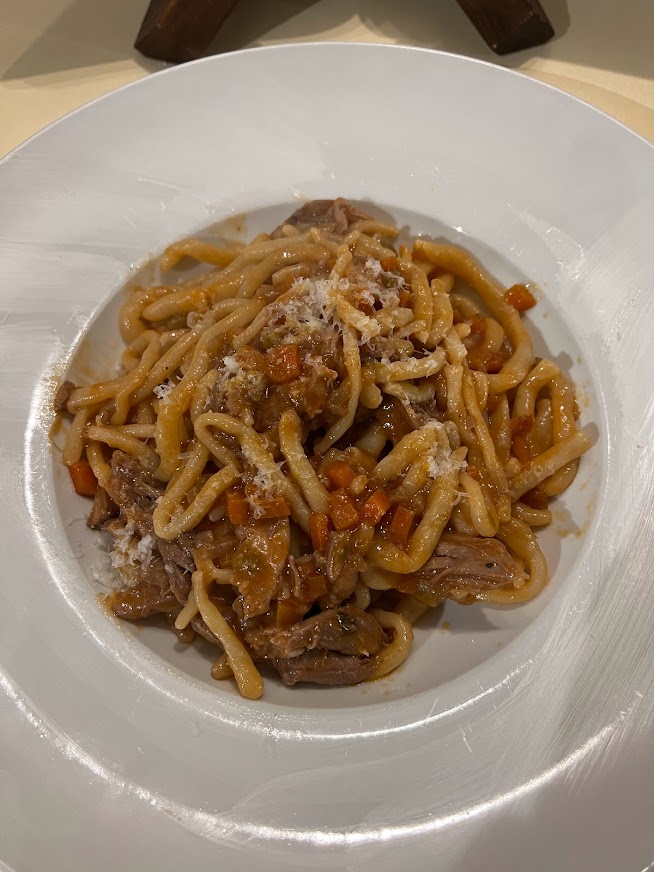Hand Rolled Spaghetti With Duck Ragu
When I traveled to New York City for the first time I spared no expense on food and ate out for every meal.
One of those meals took us to the restaurant Via Carota, located in Greenwich Village. It’s a cozy Italian Trattoria that served traditional Italian cuisine and unique cocktails. This led me to buy their cookbook “Via Carota: A Celebration of Seasonal Cooking from the Beloved Greenwich Village Restaurant: An Italian Cookbook” and make my first dish Pici All’Anatra. Hand Rolled Spaghetti With Duck Ragu.
Duck ragu, also known as Pici all’Anatra, is a traditional Tuscan dish made with slow-cooked duck meat and a rich tomato sauce. This hearty and flavorful dish is a staple at the renowned Italian restaurant, Via Carota.
At Via Carota, the duck ragu is made with the highest quality ingredients and cooked to perfection, resulting in a dish that is both comforting and delicious. The tender duck meat is combined with a savory tomato sauce made from canned tomatoes, red wine, and a blend of herbs and spices. The sauce is then served over handmade Pici pasta, a thick spaghetti-like noodle that is a staple of Tuscan cuisine.
Since traveling to New York to go back to Via Carota is not an easy option for me I am happy with the release of their cookbook.
If you would like to check out the book click the link below!
The History of Duck Ragu
Duck ragu has its roots in Tuscan cuisine and has been enjoyed for centuries in Italy. The dish was originally created as a way to make use of every part of the duck, including the legs and other less commonly used cuts of meat. Over time, the dish evolved to include the use of rich tomato sauce, which added depth and flavor to the dish.
Today, duck ragu is a popular dish in Italy and around the world, and is often served over handmade pasta or with a crusty loaf of bread. At Via Carota, the dish is made with the same care and attention to detail that has been passed down through generations of Italian cooks.
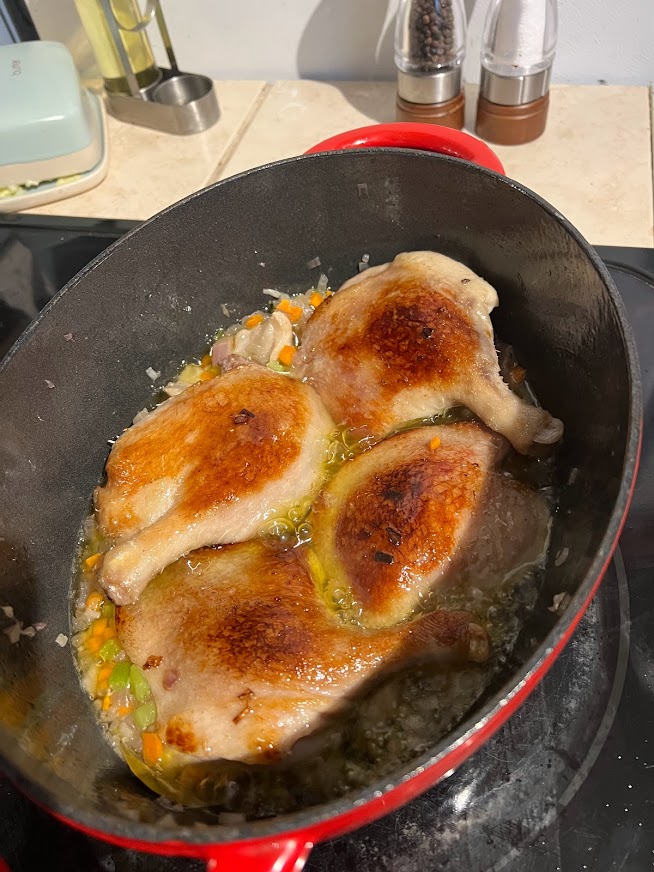
The Key Ingredients in Duck Ragu
One of the keys to a delicious duck ragu is the use of high-quality ingredients. Try to get the freshest and the highest quality duck to use in the dish, ensuring that the meat is tender and flavorful. The sauce is made from tomatoes that are slow-cooked with red wine, herbs, and spices to create a rich and savory sauce.
The pasta used in the dish is also an important factor in the overall flavor and texture of the dish. Making the Pici pasta ensures that it is fresh and has the perfect texture to hold the sauce.
The Cooking Method for Duck Ragu
The slow-cooking process is what sets duck ragu apart from other pasta dishes. The duck is cooked slowly over low heat, allowing the flavors to meld and the meat to become tender. The tomato sauce is also cooked slowly, allowing the flavors to deepen and intensify. The result is a rich and flavorful dish that is both comforting and satisfying.
The dish is also made with love and care, just as it has been made in Italian kitchens for centuries.
Making Perfect Pici Pasta: An Affordable and Egg-Free Dough Recipe
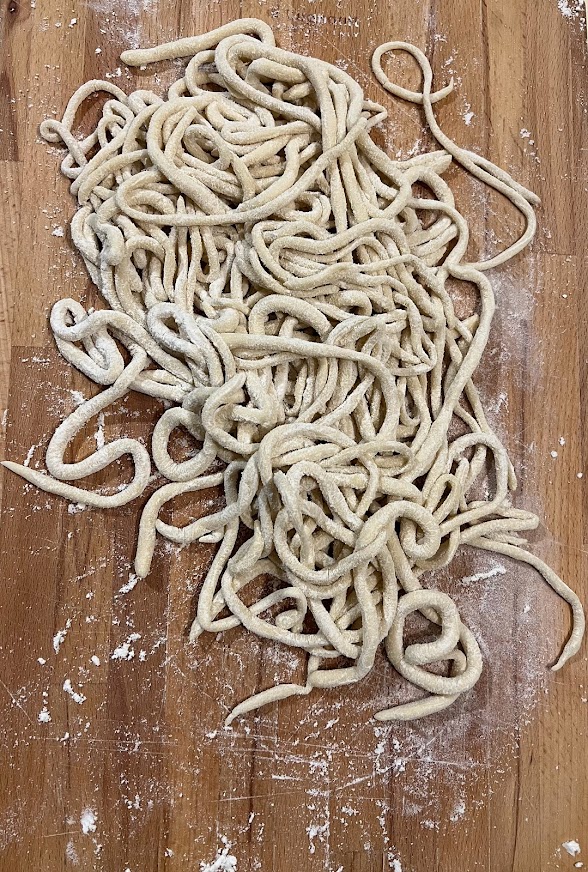
Pici pasta is a thick and hearty pasta that originated from Tuscany, Italy. It’s a simple and traditional pasta made with only flour and water, making it a perfect option for those who are on a budget or have an allergy to eggs. In this article, we will walk you through the step-by-step process of making the perfect pici pasta dough and share tips and tricks to help you achieve the perfect texture and flavor every time.
The Key Ingredients
- Flour: Use high-quality, 00 flour and semolina for the best results.
- Water: You should keep a cup of warm water to the side to add more hydration if needed, or semolina if your dough is too wet.
- Salt: A pinch of salt will enhance the flavor of the pasta.
- Extra Virgin Olive Oil: Quality olive oil will create a great taste and texture.
Measure Ingredients with Precision
It is crucial to measure the ingredients accurately to get the perfect dough consistency. Instead of using a measuring cup, use a scale to measure the dry ingredients for more accuracy. If you do this it will help ensure that your dough is not too wet or too dry, which can affect the final result.
The Importance of Kneading
Once you have the ingredients combined, knead the dough for a minimum of 10 minutes. This process is crucial as it helps to develop the gluten, which gives the pasta its elasticity and chewiness. If you don’t knead the dough enough, the pasta will spring back to its original shape and won’t roll out.
Resting the Dough
After kneading the dough, wrap it in plastic wrap and let it rest at room temperature for a minimum of one hour. This will allow the gluten to relax and make the dough easier to work with.
Shaping the Pici Pasta
Hydration and moisture are also very important when shaping the pasta. If the cutting board is too dry, the pici will slide along rather than grip to the board, making it difficult to roll out. Keep a damp cloth nearby to constantly keep your cutting board damp. However, make sure that you place the finished shaped pici on a floured surface or else it will stick together or to the sheet pan.
Making Pasta Ahead of Time
If you’re making pasta ahead of time, wrap the dough and refrigerate it for up to a day. This will allow the flavors to develop and the dough to mature, resulting in a more delicious and flavorful pasta
Making pici pasta is a simple and affordable way to enjoy a delicious and traditional pasta dish. By following these tips and tricks, you can create the perfect pici pasta every time. Remember, the key to success is accurate measurements, proper hydration, and ample kneading and resting time. So, next time you’re in the mood for a hearty and satisfying pasta dish, give pici pasta a try.
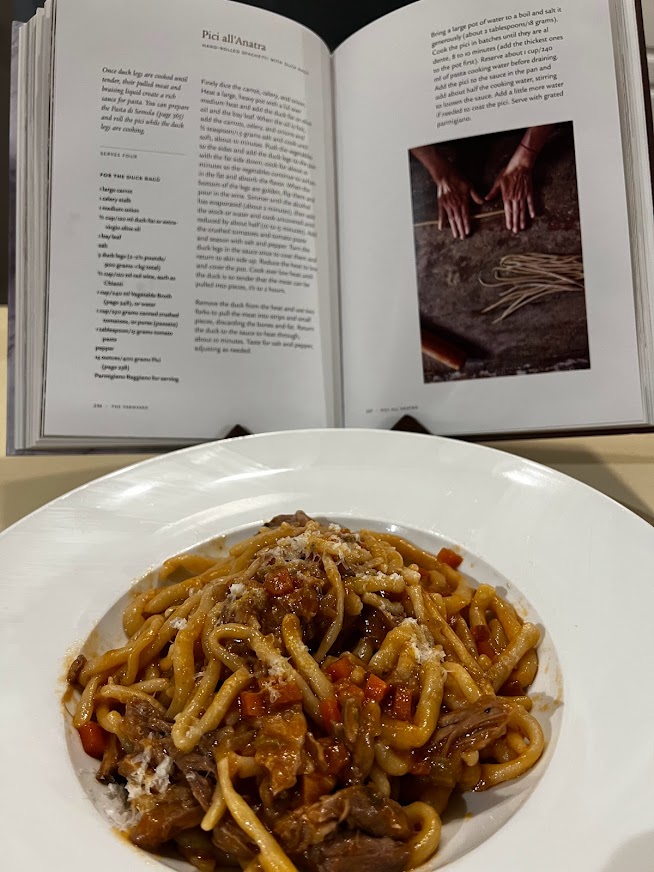
If you would like to check out the book click the link above!
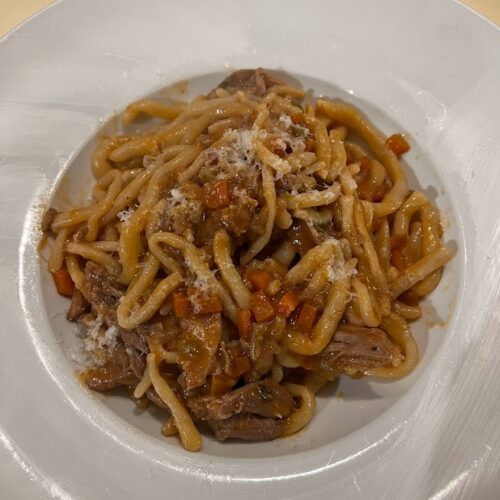
Pici All’Anatra – Handrolled Pasta with Duck Ragu
Ingredients
For the Duck Ragu
- 1 Large Carrot
- 1 Stalk Celery
- 1 Medium Onion
- ½ cup / 120 ml Duck fat or extra virgin olive oil
- 1 Bay leaf
- salt
- 3 Duck legs 2-2 1/2 pounds / 900 grams – 1 kg total
- ½ cup / 120 ml Red wine Such as Chianti
- 1 cup / 240 ml Vegetable broth or water
- 1 cup / 250 grams Canned crushed tomatoes, or puree (passata)
- 1 tablespoon / 15 grams tomato paste
- Pepper
- 14 ounces / 400 grams Pici
- Parmigiano Reggiano For serving
For the Pici
- 1 cup / 116 grams type 00 flour
- 1 cup / 150 grams semolina
- salt pinch
- 2 tbsp / 30 ml extra-virgin oilive oil
- ½ cup plus 2 tbsp / 150 ml water
Instructions
For the Dough
- Whisk the flour, semolina, and a large pinch of salt together in a bowl, then pour onto a work surface in a mound.
- Make a deep well in the center of the flour with a fork. Add the olive oil and about 1/4 cup / 60 ml water. Use the fork or your fingers to gradually incorporate flour from the inside of the well, mixing from the bottom first in a circular motion. Pir in the remaining water, and gather the mixture into a shaggy dough using a bench scraper and your hands. Pat into a firm dough and scrape the work surface clean.
- Work the dough vigorously, kneading and folding it into a ball. Continue kneading until the dough is smooth and elastic, 10-15 minutes. Slight flatten the ball of dough and place a bowl over it, or wrap it tightly with plastic wrap.
- Rest the dough for 1 hour and up to 24 hours in the fridge before rolling and cutting.
To make the Pici
- Have a sheet pan dusted with semolina.
- Divide the dough in half. Cover one half with a bowl while you work.
- With a rolling pin, roll the dough on a very lightly floured board until you have a sheet about 1/3 inch / 5mm thick.
- Cut the pasta into short pieces (1-2 inches / 2.5-5cm).
- Roll a piece of pasta between your hands into a short rope, then place it on the board. Place the palms of your hands on top of the pasta rope, and with fingers outstretched, roll the dough back and forth. Work gradually toward the ends to lengthen the dough.
- Continue rolling and stretching outward until the rope is thin (pici will expand when cooked) and about 1 inch / 25 cm long. Don't try to make them perfect; they will be irregular.
- Lay the pici put on the sheet pan with space between them, and sprinkle with semolina to prevent them from sticking. You can cook them immediately or them dry until firm.
For the Duck Ragu
- Heat large pot over medium heat.
- Add duck fat or olive oil and bay leaf.
- Add finely diced carrot celery and onion when the oil is hot. Season with salt. Cook until soft.
- Move the veg to the side of the pot. Place duck leg skin side down into the bottom of the bare pot. Sear until golden brown. About 10 minutes.
- Flip the legs and add wine. Simmer until the alcohol is cooked off (a couple of minutes), add stock or water, and cook uncovered until reduced by about half. Stir in the passata and tomato paste.
- Move duck legs to coat all sides and leave skin side up. Cook on low heat until meat is tender. Approx 2 hours.
- Remove duck legs from pot and allow to cool. Using tongs, remove duck meat from bones and any skin that did not render off. Shred duck meat using forks. Add meat back into the pot. Season with salt and pepper to taste. Skim off any excess fat from the top using a ladle.
- Bring a separate large pot of salted water to a boil. Cook pici until Al dente, approx 9 minutes.
- Reserve a cup or two of pasta water before draining. Add cooked pasta to the sauce and about a half cup of pasta water and stir to emulsion the water with the sauce. Add more pasta water if needed to thin the sauce out to preference. Serve with grated Parmesan
